|
|
|
|
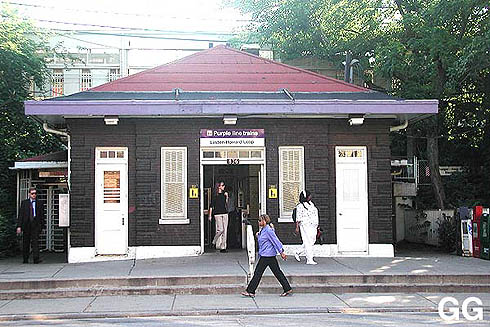 The Main station house, looking west on Chicago Avenue on June 25, 2001. Several elements such as the brickwork, quoins, and symmetry give the station house a Georgian Revival influence. For a larger view, click here. (Photo by Graham Garfield) |
|
|
|
|
 The Main station house, looking west on Chicago Avenue on June 25, 2001. Several elements such as the brickwork, quoins, and symmetry give the station house a Georgian Revival influence. For a larger view, click here. (Photo by Graham Garfield) |
Main
(900N/732W)
Main Street and Chicago
Avenue, City of Evanston
Service Notes:
Purple Line: Evanston
Transfer to Metra: Union Pacific - North Line
Quick Facts:
Address: 836 Chicago Avenue
Established: May 16, 1908
Original Line: Northwestern Elevated Railroad, Evanston branch
Previous Names: South Evanston
Skip-Stop Type: All-Stop
Rebuilt: 1909
Status: In Use
History:
"L" service first entered north Chicago and Evanston by way of an agreement to use the tracks of the Chicago, Milwaukee and St. Paul Railway's tracks, replacing the steam service that the St. Paul had previously provided. The Evanston City Council authorized the electrification of the tracks of the Chicago, Milwaukee and St. Paul Railroad's tracks in their city in March 1907, but also required that the grade-level tracks be elevated between Howard Avenue at the south city limits and University Place at the north end of downtown by the end of 1910. "L" service north of Wilson to Central Avenue in Evanston began on May 16, 1908.
The St. Paul had a station named South Evanston at Main Street and Chicago Avenue. The station, of a style typical of railroad depots, was located on the west side of the tracks south of Main Street. As they did at the other stations on the newly electrified line, the Northwestern Elevated Railroad chose not to use the station facilities of the St. Paul steam railroad, which were situated and designed for the needs of a main line commuter railroad rather than a rapid transit service. Instead, the Northwestern built a new station at the same location as the St. Paul's station. The "L" station facility at South Evanston (Main Street) was a simple ground-level station and modest platform. The station house was a small, wood frame building set between the two tracks at ground level with a wooden walkway and stairs leading up to it from the street. The exterior used clapboard siding and a hipped roof with eaves. The rear opened out onto an island platform. The platform had a short canopy with a hipped roof (which was actually a continuation of the station house's roof) and center wooden columns with angled brackets, and wood decking.
Track Elevation and a New Station
The ground-level wood-frame station's use was short-lived, as work on the project to elevate the tracks through south Evanston, per the Northwestern Elevated's franchise from the City of Evanston, began soon after service started. Construction of an embankment to grade-separate the tracks began in during the last week of October 1908. The Chicago & North Western Railway, which ran parallel and adjacent to the "L" through south Evanston, elevated their tracks at the same time. The elevation project was largely completed by the end of 1910.
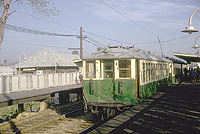
Car 4296 brings up the rear of the Linden-bound Evanston train stopped at Main, looking north on October 21, 1968. The C&NW's Main Street-Evanston station is seen on the left. Note also the 1950s-era black and white station name sign on the southbound "L" platform. For a larger view, click here. (Photo by Doug Grotjahn, Collection of Joe Testagrose) |
The original side platforms, a steel structure and canopy with wood decking, remain. The original metal railings near the center the platforms (the original sections) also remain, supplemented by simpler wooden railings on the platform extensions. Newer sodium vapor "shoe box" lights and fluorescent lights beneath the canopies illuminate the platforms. Two bus stop shelters provide further protection from the elements, substituting for windbreaks. The trees surrounding the platforms are sometimes a bit overgrown, extending over the platforms and growing down onto and through the railings. The lush foliage growing on and around the early 20th century platforms give the station an almost rural feel.
In anticipation of one-person operation being implemented on the Purple Line, the northbound platform was extended 90 feet south over Washington Street in June 1997. This was required because the far north end of the northbound platform is slightly curved, which prevents the motorman from seeing all the way down the side of the train from the front cab window. This new extension entered service on June 16th -- with the berthing markers moved 25 feet south at the same time -- with one-person train operation (OPTO) implemented a few days later on June 22nd.
As part of the CTA's 2004-2008 Capital Improvement Plan, funding was provided for the design of extensive renovations at Main. The station would have been accessible when reconstruction was complete. Funding was anticipated in the 2004-08 CIP for the reconstruction of Main in 2008, but this plan was not pursued.
During late Spring 2008, Main received new station signage. The older KDR-type station name signs were replaced with new Green Line Graphic Standard versions. The station name signs, station symbol signs, and "board here" signs on the platforms were all replaced with new porcelain signs incorporating the line's color mounted on new frames and mountings. The sign over the station's front entrance was also replaced with a new sign displaying the station's name and route, per the current standard.
After OPTO was implemented on the Purple Line and northbound trains' berthing was shifted south onto the newly-extended northbound platform, the curved 60 feet or so at the north end of the platform was no longer used by trains. This section remained open but unused for a while, but later a new end railing was installed just before the curvature of the platform started to close the unneeded portion off from passengers. No longer needed for operations, this portion of the platform was allowed to fall into disrepair. It was finally dismantled and removed in October 2013.
Red-Purple Lines Modernization (RPM) Project
Due to the deteriorating condition of the infrastructure on the Red Line north of Belmont and on the Purple Line, the CTA initiated the Red-Purple Modernization Project (RPM) to bring the existing transit stations, track systems, and structures into a state of good repair. The project, which stretches along the existing Red and Purple lines from north of Belmont station to Linden terminal, would help bring the existing transit line into a state of good repair, reduce travel times, improve access to job markets and destinations, and provide improved access to people with disabilities.
The project began in 2009 with a vision study to assess the scope of needs and develop a set of alternatives for study. In 2010, in accordance with the National Environmental Policy Act (NEPA), CTA and Federal Transit Administration (FTA) initiated the environmental review process for the project and undertook work to develop an Environmental Impact Statement (EIS). The process included numerous public meetings and input opportunities, and study of various alternatives for achieving a good state of repair for the infrastructure in the project area.
A number of alternatives are under consideration for the RPM project, including the comprehensive reconstruction of track, stations, and structures along the line. The four options currently under consideration and study, not including an FTA-required "no action" baseline scenario, include:
The Modernization with Station Consolidation option includes the consolidation of South Blvd. and Main stations by closing the existing South Blvd. station and adding a new entrance to Main at Madison Avenue, approximately two blocks north of South Blvd. station and one block south of Main station.
Other alternatives considered earlier in the study but subsequently eliminated due to public comment and further study included basic rehabilitation without adding a transfer station at Loyola, a modernization option with only three tracks between Lawrence and Howard, and a modernization option with a 2-track subway under Broadway.
The full-scale modernization envisioned on the Red-Purple Modernization Project could cost anywhere from $2.5 to $5 billion. On February 8, 2012, the CTA board retained Goldman Sachs & Co. to lead the search for public-private partnerships to help finance the reconstruction, which has no firm date. Goldman Sachs will work with Chicago-based Loop Capital Markets LLC and Estrada Hinojosa & Co., but will accept no fee for the first year as it determines the ability to raise private capital.
See CTA's Red & Purple Modernization page for more information about the scoping and planning process, and the various alternatives being considered.
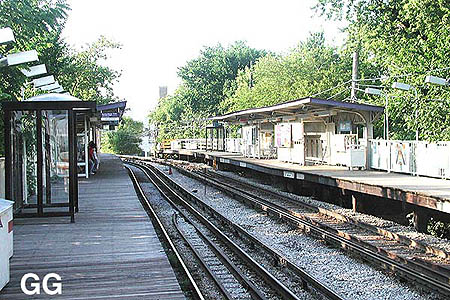 The dual side platforms at Main, looking north on the southbound platform on June 25, 2001. The lush green foliage growing around the platforms give the scene a distinctly European suburban feel. For a larger view, click here. (Photo by Graham Garfield) |
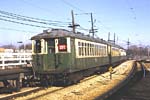 |
cta4000s09.jpg
(139k) |
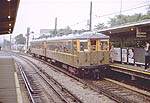 |
cta4272f.jpg
(141k) |
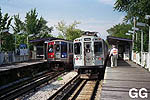 |
main03.jpg
(80k) |
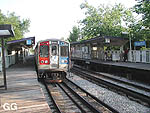 |
main04.jpg
(162k) |
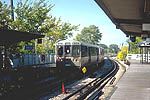 |
cta2838a.jpg
(134k) |
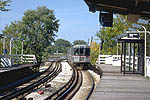 |
cta2858b.jpg
(135k) |
 |
cta49b.jpg
(129k) |
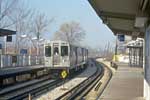 |
cta2883.jpg
(117k) |
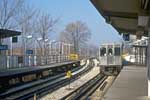 |
cta2772.jpg
(123k) |
![]()
|
|